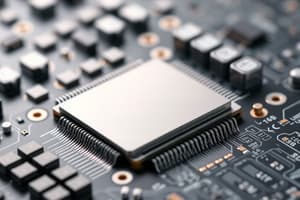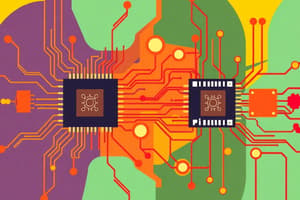Podcast
Questions and Answers
What role does IoT play in embedded systems applications?
What role does IoT play in embedded systems applications?
IoT connects billions of devices and sensors to the internet for data collection and sharing.
How have embedded systems impacted autonomous vehicles?
How have embedded systems impacted autonomous vehicles?
Embedded systems enable real-time decision-making and control in autonomous vehicles.
What distinguishes general-purpose computing systems from embedded systems?
What distinguishes general-purpose computing systems from embedded systems?
General-purpose systems are designed for a wide range of applications, while embedded systems serve specific dedicated functions.
Describe the hardware characteristics typically found in embedded systems.
Describe the hardware characteristics typically found in embedded systems.
What advancements have contributed to the evolution of embedded systems?
What advancements have contributed to the evolution of embedded systems?
How does the integration of AI enhance embedded systems?
How does the integration of AI enhance embedded systems?
Give an example of an application that leverages IoT in agriculture.
Give an example of an application that leverages IoT in agriculture.
What efficiency advantages do embedded systems offer over general computing systems?
What efficiency advantages do embedded systems offer over general computing systems?
What is an embedded system, and why are they important in everyday devices?
What is an embedded system, and why are they important in everyday devices?
How do embedded systems differ from general-purpose computers?
How do embedded systems differ from general-purpose computers?
What are some characteristics that define embedded systems?
What are some characteristics that define embedded systems?
Can you provide a real-life example of an embedded system and its purpose?
Can you provide a real-life example of an embedded system and its purpose?
In what ways have embedded systems impacted the automotive industry?
In what ways have embedded systems impacted the automotive industry?
What role do embedded systems play in the Internet of Things (IoT)?
What role do embedded systems play in the Internet of Things (IoT)?
What types of devices typically utilize embedded systems?
What types of devices typically utilize embedded systems?
Why are efficiency and reliability important characteristics of embedded systems?
Why are efficiency and reliability important characteristics of embedded systems?
What is the primary purpose of embedded systems?
What is the primary purpose of embedded systems?
How do embedded systems contribute to industrial automation?
How do embedded systems contribute to industrial automation?
What distinguishes real-time control systems in embedded applications?
What distinguishes real-time control systems in embedded applications?
In what way do embedded systems contribute to signal processing?
In what way do embedded systems contribute to signal processing?
Describe the role of embedded systems in data acquisition.
Describe the role of embedded systems in data acquisition.
What communication functions do embedded systems provide?
What communication functions do embedded systems provide?
What types of user interfaces can embedded systems provide?
What types of user interfaces can embedded systems provide?
How do embedded systems enhance security in various applications?
How do embedded systems enhance security in various applications?
What is the primary characteristic of non-real-time embedded systems?
What is the primary characteristic of non-real-time embedded systems?
How do small-scale embedded systems differ from large-scale embedded systems?
How do small-scale embedded systems differ from large-scale embedded systems?
What defines microcontroller-based embedded systems?
What defines microcontroller-based embedded systems?
In what applications are digital signal processor (DSP)-based embedded systems commonly used?
In what applications are digital signal processor (DSP)-based embedded systems commonly used?
What are some typical applications of automotive embedded systems?
What are some typical applications of automotive embedded systems?
How do IoT embedded systems differ from non-IoT embedded systems?
How do IoT embedded systems differ from non-IoT embedded systems?
What is a key characteristic of medium-scale embedded systems compared to small-scale systems?
What is a key characteristic of medium-scale embedded systems compared to small-scale systems?
What are industrial embedded systems primarily used for?
What are industrial embedded systems primarily used for?
What operational systems do typical desktop computers run compared to embedded systems?
What operational systems do typical desktop computers run compared to embedded systems?
In terms of hardware components, how do embedded systems differ from general-purpose computing devices?
In terms of hardware components, how do embedded systems differ from general-purpose computing devices?
What is the typical programming language used for developing embedded systems, and why?
What is the typical programming language used for developing embedded systems, and why?
Describe a key use case for embedded systems and a characteristic that supports this use case.
Describe a key use case for embedded systems and a characteristic that supports this use case.
How does the flexibility of general-purpose computers compare to that of embedded systems?
How does the flexibility of general-purpose computers compare to that of embedded systems?
What are the implications of needing hardware changes for modifications in embedded systems?
What are the implications of needing hardware changes for modifications in embedded systems?
What type of user interfaces are commonly found in embedded systems?
What type of user interfaces are commonly found in embedded systems?
What distinguishes the use of embedded systems in industrial automation from their use in consumer electronics?
What distinguishes the use of embedded systems in industrial automation from their use in consumer electronics?
Study Notes
What are Embedded Systems and Where are They Used?
- Embedded systems are specialized computer systems that perform a dedicated task.
- They are efficient, reliable, and operate in real-time.
- Embedded systems are commonly used in consumer electronics, such as smartphones, digital cameras, and smart TVs.
- They are used in automotive systems like engine control units (ECUs), infotainment, navigation systems, and advanced driver-assistance systems.
- Embedded systems control machines, robots, and manufacturing processes in the industrial sector.
- In the medical sector, they power pacemakers, insulin pumps, and other medical imaging equipment.
- They are used in aircraft control systems, missiles, and military communication systems.
- Modern household appliances, washing machines, and refrigerators, use embedded systems for efficiency and enhanced functionality.
- Embedded systems are fundamental to the Internet of Things (IoT), connecting sensors and actuators to the internet for data collection and control.
Comparing Embedded Systems to General Computing Systems
- General-purpose computers are versatile, designed to run various applications, and have high processing power, memory, and storage resources.
- Embedded systems are designed for dedicated functions and focus on efficiency, reliability, and real-time operation.
- Embedded systems have limited processing power, memory, and storage resources.
- Embedded systems feature custom-designed and specialized hardware components.
- General-purpose computers use full-fledged operating systems like Windows, macOS, and Linux.
- Embedded systems utilize real-time operating systems (RTOS) or specialized firmware.
Embedded Systems Characteristics
- Embedded systems often operate in real-time, responding to events within a specific timeframe.
- They can be categorized by their complexity, hardware characteristics, application domain, and connectivity.
- Based on Complexity:
- Small-Scale Embedded Systems are simple and have limited processing power, memory, and functionality, such as microcontrollers in appliances.
- Medium-Scale Embedded Systems are more complex, with greater processing capabilities, such as automotive engine control units (ECUs).
- Large-Scale Embedded Systems are highly complex with advanced features, such as aerospace and industrial automation systems.
- Based on Hardware characteristics:
- Microcontroller-Based Embedded Systems use microcontrollers (CPU, memory, and I/O integrated).
- Microprocessor-Based Embedded Systems use a microprocessor (CPU), offering more versatility, and are common in various devices.
- Digital Signal Processor (DSP)-Based Embedded Systems are optimized for processing analog signals, often employed in audio/video processing, image recognition, and filtering.
- Based on Application Domains:
- Automotive Embedded Systems are used in engine control units, infotainment systems, and advanced driver assistance systems (ADAS)
- Industrial Embedded Systems control machines in manufacturing and process control systems.
- Consumer Electronics Embedded Systems are found in smartphones, smart TVs, and gaming consoles.
- Medical Embedded Systems are found in pacemakers, MRI machines, and patient monitoring systems.
- Aerospace and Defense Embedded Systems are used in aircraft, satellites, and military equipment.
- Based on Connectivity:
- IoT Embedded Systems are connected to the internet through networks to collect and exchange data.
- Non-IoT Embedded Systems are isolated, communicating through local networks.
Purposes of Embedded Systems
- Automation:
- Embedded systems are used in industrial settings to monitor processes, make real-time decisions, and optimize production.
- Real-Time Control:
- Embedded systems respond to inputs and events with minimal latency, making them suitable for robotics, automotive control, and medical devices.
- Signal Processing:
- They use DSPs to process real-time signals such as audio, video, image recognition, and filtering applications.
- Data Acquisition and Monitoring:
- Embedded systems monitor environmental conditions, measure performance, and facilitate informed decisions.
- Communication:
- Embeddes systems enable communication between devices through both wired and wireless networks like IoT devices, networking equipment, and telecommunications.
- User Interface:
- They provide user interfaces ranging from simple LED displays to complex touchscreens.
- Security:
- Embedded systems are integral to access control, surveillance, and encryption systems to monitor and manage security threats.
Studying That Suits You
Use AI to generate personalized quizzes and flashcards to suit your learning preferences.
Related Documents
Description
Explore the fascinating world of embedded systems, specialized computer systems designed for dedicated tasks. This quiz covers various applications of embedded systems, including their use in consumer electronics, automotive technologies, industrial automation, medical devices, and more. Discover how these systems play a crucial role in everyday life and emerging technologies.




